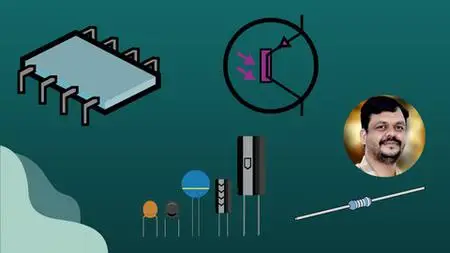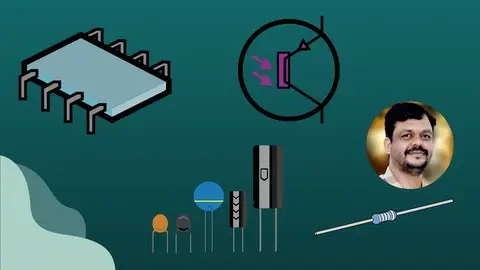Learn Bipolar Junction Transistor ( Bjt ) - From Basics
Last updated 11/2021
MP4 | Video: h264, 1280x720 | Audio: AAC, 44.1 KHz
Language: English | Size: 18.36 GB | Duration: 14h 18m
Last updated 11/2021
MP4 | Video: h264, 1280x720 | Audio: AAC, 44.1 KHz
Language: English | Size: 18.36 GB | Duration: 14h 18m
Learn BJT from very basics to Advance level
What you'll learn
Be able to learn the basics of Transistor ( Bipolar Junction Transistor )
Be able to learn operating modes of BJT
Be able to learn current components of BJT in active region
Be able to learn characteristics of BJT
Be able to learn Amplifiers, Oscillators and Power amplifiers
Be able to learn Feedback amplifiers and Multistage amplifiers
Requirements
Basic semiconductor Theory
Description
The Bipolar Junction Transistor is a semiconductor device which can be used for switching or amplificationThis Course deals with basics of BJT, BJT characteristic's, BJT biasing Techniques( Fixed bias, collector to Base bias and voltage divider bias), BJT amplifiers ( CB, CE, CC amplifiers), small signal model of BJT( Hybrid model ), Feedback amplifiers, Oscillators ( RC and LC ), Multistage amplifiers and Power amplifiers.If we now join together two individual signal diodes back-to-back, this will give us two PN-junctions connected together in series which would share a common Positve, (P) or Negative, (N) terminal. The fusion of these two diodes produces a three layer, two junction, three terminal device forming the basis of a Bipolar Junction Transistor, or BJT for short.Transistors are three terminal active devices made from different semiconductor materials that can act as either an insulator or a conductor by the application of a small signal voltage. The transistor’s ability to change between these two states enables it to have two basic functions: “switching” (digital electronics) or “amplification” (analogue electronics). Then bipolar transistors have the ability to operate within three different regions:Active Region – the transistor operates as an amplifier and Ic = β*IbSaturation – the transistor is “Fully-ON” operating as a switch and Ic = I(saturation)Cut-off – the transistor is “Fully-OFF” operating as a switch and Ic = 0The word Transistor is a combination of the two words Transfer Varistor which describes their mode of operation way back in their early days of electronics development. There are two basic types of bipolar transistor construction, PNP and NPN, which basically describes the physical arrangement of the P-type and N-type semiconductor materials from which they are made.The Bipolar Transistor basic construction consists of two PN-junctions producing three connecting terminals with each terminal being given a name to identify it from the other two. These three terminals are known and labelled as the Emitter ( E ), the Base ( B ) and the Collector ( C ) respectively.Bipolar Transistors are current regulating devices that control the amount of current flowing through them from the Emitter to the Collector terminals in proportion to the amount of biasing voltage applied to their base terminal, thus acting like a current-controlled switch. As a small current flowing into the base terminal controls a much larger collector current forming the basis of transistor action.The principle of operation of the two transistor types PNP and NPN, is exactly the same the only difference being in their biasing and the polarity of the power supply for each type.
Overview
Section 1: Introduction
Lecture 1 Introduction
Lecture 2 Terminals of BJT
Lecture 3 BJT Symbols
Lecture 4 BJT Operating Modes
Lecture 5 Current components of BJT in active mode
Lecture 6 Current components of BJT in active mode - 1
Lecture 7 BJT Configurations
Lecture 8 Relation between Alpha and Beta
Lecture 9 Important points
Lecture 10 Practice questions and answers
Section 2: BJT Characteristics
Lecture 11 Collector current of BJT
Lecture 12 Early Effect
Lecture 13 Common Base Input characteristics
Lecture 14 Common Base output characteristics
Lecture 15 Common Emitter ( CE ) Characteristics
Lecture 16 CB, CE,CC comparison
Lecture 17 Procedure to find region of the transistor
Lecture 18 Thermal Runaway
Section 3: BJT Biasing
Lecture 19 Introduction
Lecture 20 Selection of operating point
Lecture 21 Selection of operating point - 1
Lecture 22 Instability in collector current
Lecture 23 Stability Factor
Lecture 24 Biasing Techniques
Lecture 25 Fixed Bias ( Base Bias )
Lecture 26 Collector to Base bias
Lecture 27 Voltage Divider Bias
Lecture 28 Practice Problems from Biasing
Lecture 29 Practice Problems from Biasing - 1
Lecture 30 Compensation Techniques
Lecture 31 Diode Compensation Technique
Lecture 32 Thermistor Compensation Technique
Section 4: Small Signal Amplifiers
Lecture 33 Introduction
Lecture 34 Hybrid model ( H-parameter model )
Lecture 35 Hybrid model ( H-parameter model ) -1
Lecture 36 CE Amplifier
Lecture 37 CC Amplifier ( Emitter follower )
Lecture 38 Hybrid model analysis
Lecture 39 Approximate model
Lecture 40 CE amplifier hybrid model analysis
Lecture 41 CE amplifier hybrid model analysis - 1
Lecture 42 CE amplifier approximate analysis
Lecture 43 CE amplifier approximate analysis - 1
Lecture 44 CB amplifier approximate analysis
Lecture 45 CC Amplifier analysis
Section 5: HIGH FREQUENCY MODEL OF BJT AMPLIFIER
Lecture 46 Introduction
Lecture 47 High Frequency Model
Section 6: Feedback Amplifiers
Lecture 48 Introduction
Lecture 49 Types of feedback amplifiers
Lecture 50 Advantages of negative feedback amplifier
Lecture 51 Sensitivity of Feedback amplifier
Lecture 52 Mixer and sampling circuits
Lecture 53 Types of negative feedback amplifiers
Lecture 54 Voltage series ( voltage ) Feedback amplifier
Lecture 55 Voltage series ( voltage ) Feedback amplifier - 1
Lecture 56 Voltage Shunt Feedback amplifier-1
Lecture 57 Voltage Shunt Feedback amplifier-2
Lecture 58 Current Shunt Feedback amplifier
Lecture 59 Current Shunt Feedback amplifier - 1
Lecture 60 Comparison of Feedback amplifier
Section 7: OSCILLATORS
Lecture 61 Introduction
Lecture 62 Sinusoidal Oscillators
Lecture 63 RC phase shift oscillator -1
Lecture 64 RC phase shift oscillator -2
Lecture 65 Wein Bridge Oscillator
Lecture 66 LC Oscillator
Lecture 67 Hartley and Colpitts oscillator
Section 8: Multi-Stage Amplifiers
Lecture 68 Introduction
Lecture 69 Multi stage amplifier-1
Section 9: Power Amplifiers
Lecture 70 Introduction
Lecture 71 Power Amplifiers-1
Lecture 72 Classifications of Power Amplifier
Lecture 73 Series Fed Class - A Power amplifier
Beginners in Engineering,Electronics



